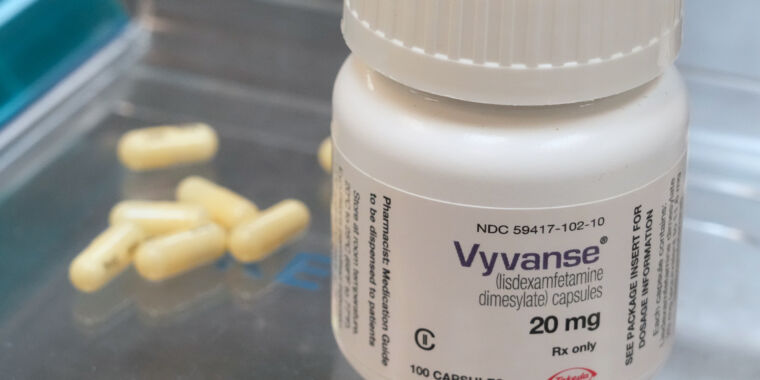While supplies of Adderall and its generic equivalents are finally recovering after years of shortages, the DEA is currently working to curb a shortage of another drug, Vyvanse (lisdexamfetamine), and its generic equivalents, which treats attention-deficit hyperactivity disorder.
This week, the D.E.A. Increase permitted production of lisdexamfetamine by approximately 23.5%This increases the current quota of 26,500 kg by 6,236 kg, for a new total of 32,736 kg. The DEA also authorized a corresponding increase in the quota for d-amphetamine, which is needed to produce lisdexamfetamine.
“These adjustments are necessary to ensure that the United States can ensure an adequate and uninterrupted supply of lisdexamfetamine to meet legitimate patient needs at home and abroad,” the DEA said.
allocation
Like Adderall (amphetamine/dextroamphetamine salts), Vyvanse (lisdexamfetamine) is classified by the DEA as an amphetamine-type stimulant. Schedule II DrugsSo the DEA manages production to ensure demand is met while preventing excess supply from ending up on the black market. The administration does this by setting “total production quotas” — which the DEA adjusted for lisdexamfetamine this week — and distributing undisclosed allotments to drug companies.
The shortage of ADHD medications is due to a number of factors, including: Medicine Industry groups have criticized the DEA’s quota system for underestimating demand and squeezing supply. For example, the Adderall shortage began in 2022 in response to labor shortages on the drug’s production lines at Teva, the manufacturer of Adderall. But while that production issue has been resolved, prescription rates have risen significantly. This is due in part to increased awareness of ADHD, broadening diagnostic criteria, and increased access due to an increase in telehealth services that have surged during the COVID-19 pandemic. In a report earlier this year, the American Society of Health-System Pharmacists pointed to the DEA’s quota system, saying, “Worse“Shortage”
in August 2023 Joint LetterIn response to these criticisms, the DEA and FDA suggested that the problem was not with the quotas, but that some manufacturers were not using up their quotas for controlled substances.
“Based on DEA’s internal analysis of inventory, production, and sales data submitted by manufacturers of amphetamine products, [which include the two ADHD drugs]”Manufacturers sold only approximately 70% of their annual allocations, leaving approximately 1 billion additional doses of vaccine that could have been produced but were not manufactured or shipped. Data to date for 2023 shows similar trends,” the FDA and DEA wrote.
The FDA and DEA said they would work with manufacturers to increase production of the scarce drugs or waive their remaining allocations.
Vyvanse shortage
The current shortage of Vyvanse and its generic equivalents presents a similarly complicated picture. The DEA increased its quota at the request of the Food and Drug Administration. In July, the FDA sent the DEA a letter asking for an increase in the quota. But The shortage actually began in June 2023.At the time, Takeda, the manufacturer of Vyvanse, said it was experiencing inventory shortages “due to a combination of increased demand and manufacturing delays.”
In August 2023, the FDA Multiple Generic Versions After Takeda’s patent expired, supplies of Vyvanse resumed, raising hopes that the introduction of generic versions would ease the shortage. But the supply problems persist. The Association for Accessible Medicines, which represents generic drug makers, wrote the DEA in November that quotas prevent generic drug makers from obtaining enough raw materials to “launch their products at full commercial scale.” According to a Bloomberg report:.
Reported by FiercePharma Another potential factor The concern has been raised by lawmakers and industry watchers, who noted the timing of Takeda’s “delayed production” just months before generic versions were set to hit the market, raising concerns that the significantly lower profit margins on generic and off-patent drugs could lead manufacturers to deprioritize them.
Finally, the DEA addressed another element in the supply chain: exports to foreign markets. While the FDA estimates that domestic demand for lisdexamfetamine will increase by 6% between 2023 and 2024, DEA export data shows that lisdexamfetamine exports increased by 34% between 2022 and 2023, and exports are expected to continue to increase after this year. Therefore, the current 23.5% quota increase for lisdexamfetamine is only partially for domestic production. In fact, only a quarter of the 6,236 kg is for the United States. According to the DEA, 1,558 kg of the increased quota is for domestic drug production, while the remaining 4,678 kg will meet increased overseas demand.
